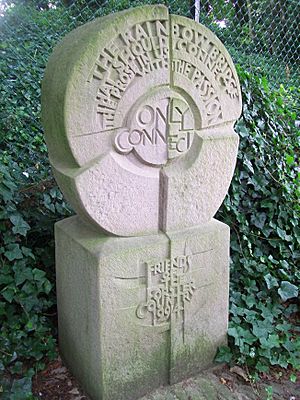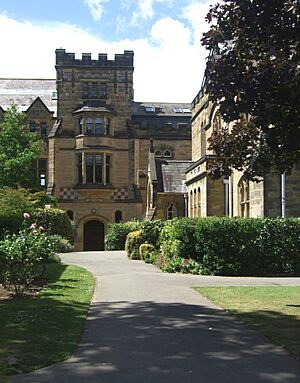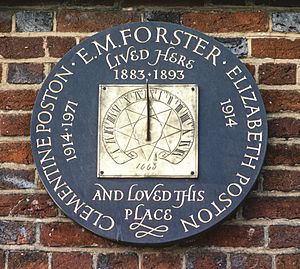E. M. Forster facts for kids
Quick facts for kids
E. M. Forster
|
|
|---|---|

Portrait of Forster by Dora Carrington, c. 1924–1925
|
|
| Born | Edward Morgan Forster 1 January 1879 Marylebone, Middlesex, England |
| Died | 7 June 1970 (aged 91) Coventry, Warwickshire, England |
| Occupation | Writer (novels, short stories, essays) |
| Alma mater | King's College, Cambridge |
| Period | 1901–1970 |
| Genre | Realism, symbolism, modernism |
| Subjects | Class division, gender, imperialism, homosexuality |
| Signature | |
 |
|
Edward Morgan Forster (born January 1, 1879 – died June 7, 1970) was a famous English writer. He is best known for his novels. Some of his most popular books include A Room with a View (1908), Howards End (1910), and A Passage to India (1924).
Forster also wrote many short stories and essays. He even helped write an opera called Billy Budd (1951). People today see him as one of the most successful English novelists from the Edwardian era.
He went to Tonbridge School and then studied history at King's College, Cambridge. There, he met other future writers like Lytton Strachey. After college, he traveled around Europe. His first novel, Where Angels Fear to Tread, was published in 1905. Many of his stories explore how different social classes interact. Forster was nominated for the Nobel Prize in Literature many times.
Contents
Life of E. M. Forster
Forster's Early Life and Education
Edward Morgan Forster was born in London on January 1, 1879. He was the only child of Alice Clara Forster and Edward Morgan Llewellyn Forster. His father was an architect who sadly died before Morgan's second birthday.
In 1883, young Morgan and his mother moved to Rooks Nest in Hertfordshire. This house later became the inspiration for "Howards End" in his famous novel. Forster had many happy memories of his childhood at Rooks Nest.
Forster inherited money from his great-aunt, Marianne Thornton. This money allowed him to become a writer. He attended Tonbridge School as a day student. The school's theatre is now named in his honor.
From 1897 to 1901, Forster studied at King's College, Cambridge. He joined a secret discussion group called the Cambridge Apostles. Many members of this group later formed the Bloomsbury Group, which Forster also joined. He earned degrees in both classics and history.
Forster's Travels and Experiences
In 1904, Forster traveled to Greece and Italy. He was interested in their ancient history. He also spent time in Germany in 1905, working as a tutor. This was a very happy time for him.
In 1906, Forster became close friends with Syed Ross Masood, a 17-year-old Indian student he tutored. Their friendship was very important to Forster.
After university, Forster traveled in Europe with his mother. They later moved to Weybridge, Surrey. This is where he wrote most of his novels.
In 1914, he visited Egypt and India. During World War I, Forster worked for the British Red Cross in Alexandria, Egypt. He helped find missing soldiers.
Forster returned to India in the early 1920s. He worked as a private secretary for the Maharajah of Dewas. His experiences in India inspired his novel A Passage to India. This book was published in 1924 and won an award.
Later Life and Recognition

In the 1930s and 1940s, Forster became a well-known voice on BBC Radio. He often reviewed books. He also supported individual freedom and spoke out against censorship.
Forster was open about his personal life with his close friends. He never married. He had a long-term friendship with Bob Buckingham, a policeman, and his wife May. Forster's circle of friends included other writers and artists. A visit to his friend Edward Carpenter and his partner inspired Forster's novel Maurice.
From 1925 until 1945, Forster lived with his mother in Abinger Hammer, Surrey. After she passed away, he moved to London. In 1946, he became an honorary member of King's College, Cambridge, where he spent his final years.
Forster received many honors for his writing. He was made a Companion of Honour in 1953. In 1969, he became a member of the Order of Merit.
E. M. Forster died on June 7, 1970, at the age of 91. He passed away at the home of his friends, the Buckinghams, in Coventry.
Forster's Literary Works
Novels by E. M. Forster

Forster published five novels during his lifetime. Another novel, Maurice, was published after his death. He also started a seventh novel, Arctic Summer, but never finished it.
His first novel, Where Angels Fear to Tread (1905), is about a young English widow who falls in love with an Italian man. Her family tries to bring her back home. This book was made into a film in 1991.
Next, he published The Longest Journey (1907). This story follows Rickie Elliott, a writer and schoolmaster. It explores themes of self-discovery and difficult relationships.

Forster's third novel, A Room with a View (1908), is a lighter, more hopeful story. It began as a story called "Lucy" in 1901. The book is about Lucy Honeychurch's trip to Italy and her choice between two very different men. This novel was adapted into a famous film in 1985.
Where Angels Fear to Tread and A Room with a View are sometimes called Forster's "Italian novels." They both feature English tourists traveling in Italy.
Howards End (1910) is a more complex novel. It looks at different groups within the English middle class. These include the intellectual Schlegel family and the wealthy Wilcox family. Howards End was made into a film in 1992 and a TV series in 2017.
Forster's most famous novel is A Passage to India (1924). It explores the relationships between people from England and India during the time of the British Raj. The story centers on an Englishwoman, an Indian doctor, and a mystery in the Marabar Caves. This book was adapted into a play and a film in 1984.
Maurice (published in 1971) returns to settings like the English countryside and Cambridge. This novel explores a relationship between men from different social classes. It was also made into a film in 1987.
Key Ideas in Forster's Writing
Forster was a humanist. This means he believed in the importance of human values and reason. His works often show people trying to connect with each other, even when society makes it difficult. He believed that humans should be curious, open-minded, and have good taste.
Many of Forster's novels, like A Passage to India and Howards End, explore how differences in social class can cause problems. A Room with a View also shows how rules of proper behavior can make it hard for people to truly connect.
Forster often used symbolism in his novels. This means he used objects or ideas to represent deeper meanings. For example, the wych elm tree in Howards End is a symbol. Characters like Mrs. Wilcox in Howards End and Mrs. Moore in A Passage to India have a special way of understanding the past and connecting with others. Forster, along with other writers, helped show characters from different countries like France, Germany, Italy, and India. Their stories often explored cultural differences.
Notable works
Novels
Short stories
|
Plays and pageants
Film scripts
Libretto
Collections of essays and broadcasts
Literary criticism
Biography
Travel writing
Miscellaneous writings
|
Notable films and drama based upon Forster's fiction
- The Machine Stops (1966), dramatised for the BBC anthology series Out of the Unknown
- A Passage to India (1984), dir. David Lean
- A Room with a View (1985), dir. James Ivory
- Maurice (1987), dir. James Ivory
- Where Angels Fear to Tread (1991), dir. Charles Sturridge
- Howards End (1992), dir. James Ivory
- Howards End (2017), BBC One miniseries, dir. Hettie MacDonald
- The Inheritance (2018), play by Matthew Lopez, adapted from Howards End, and featuring Forster as a character
See also
 In Spanish: E. M. Forster para niños
In Spanish: E. M. Forster para niños




